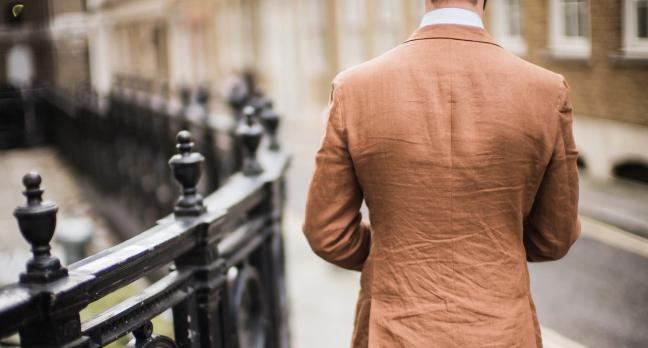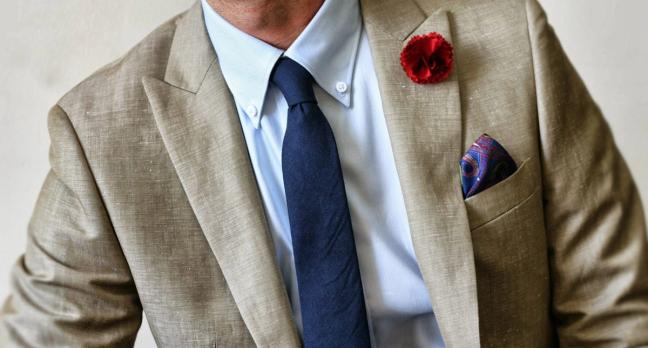The definitive guide to the summer suit
Let the experts explain how you should be tailoring your formal wardrobe for summer
The challenges of the summer suit are several. From material and cut to accessorising and colour, the number of potential pitfalls involved with this particular form of formalwear are so daunting that many simply choose to forgo the outfit altogether.
But worry not, gentlemen, for we have compiled the definitive guide to perfecting every imaginable aspect of this tricky ensemble. Using tips and tricks from some of Britain’s top stylists and services, the rules that follow will show you that ‘summer formal’ is a look not only easily achieved, but absolutely worth the effort.

Langa
“When we design our own bespoke summer suits for clients,” says Mayfair-based personal stylist Daniel Johnson. “I always recommend a linen, silk and wool mix with a quarter or skeleton lining. This fabric gives a lovely balance of weight, breathability and elegance – it tailors up beautifully.
“I would try to avoid pure linen because of the creasing – however, if you do take the plunge with a linen suit, here’s a tip: roll up an old towel and stuff the sleeve before ironing your jacket. There’s nothing worse than an ironed crease down the sleeve of a linen jacket.”
“As paler summer suits go hand in hand with warmer climes, most men naturally gravitate towards fabrics such as linen and cotton,” adds Jack McLaren-Stewart, of personal styling service The Chapar.
“But the main thing you need to look out for is breathability and weight. A 7.5oz panama weave will, by its nature, allow more air to flow through the fabric than a 16oz Harris Tweed, and thus keep you cooler and more comfortable in the heat.”
Sarah Gilfillan, of wardrobe management service Sartoria Lab, agrees.
“Linens, and textured fabrics like herringbone lend themselves well to light coloured suits. Plain beige cotton gives a safari feel and this summer I’ve also noticed a lot of seersucker around which classically comes in a pale blue and white stripe – a perfect choice if you prefer a crisper fabric than linen.”

“I find a light to medium grey is the best option,” opines Daniel Johnson, “especially if you need to work – because grey is the easiest colour to style from office to evening. People tend not to take you seriously when you wear pastels in a business environment.”
But Gabrielle Teare, a London-based personal shopper and stylist, believes you can be a little more colourful.
“With summer suits, the colour should generally be lighter than your winter darks,” says the stylist. “Stone linen can look very chic and is also very comfortable. That’s not to say that a navy linen suit doesn’t have its place. And if you really want to stand out, white trousers and shirt with a navy or olive green jacket could be a nice choice.”
“Stone and light grey are classics lighter choices for summer and easy neutral shades to wear,” offers Sarah Gilfillan. “If you’re feeling more adventurous you could choose a pale blue or pale pink, but look for dusty, muted shades to avoid looking like an ice-cream seller.
“Cream is edging rather too close to white for my liking,” she adds “- and harder to pull off – so, unless you’re very sure of your sartorial abilities, I’d steer clear of it.”
Jack McLaren-Stewart similarly champions stone as a choice.
“By its nature, summer tends to afford a greater range of colours than the depths of winter. That said, it’s easy to go overboard. For most, a lightly-coloured suit is already inherently bolder than its navy or charcoal counterparts. Therefore I’d recommend starting with stone. It’s not only classic, it also allows you to experiment with a greater range of accessories without looking as if you’re trying too hard.”

Indochino
“White always looks crisp with a light coloured suit but can be too pale for some men and make them look washed out,” warns Sarah Gilfillan. If this is the case for you then I recommend going a shade or two darker than the suit you’re wearing or adding in another colour.
“A pale blue suit with a mid-denim blue shirt, or a light beige with a pale pink shirt. Beware of going too dark though, as it’ll create too much of a contrast and the Al Pacino Scarface look is probably not what you’re after!”
Daniel Johnson, however, disagrees. He believes that to keep things right, you should keep it light.
“I always advise the shirt to be lighter in colour than the suit,” says the stylist. “The human eye is trained to focus on the lightest and brightest part of an outfit first and considering that your shirt is the garment closest to your face, it stands to reason that you want to attract attention to your most unique feature.”
Jack McLaren-Stewart agrees with Johnson.
“Your shirt should always be lighter,” he says, “lest you run the risk of veering into Al Capone – or nightclub bouncer – territory. A pale blue shirt works beautifully with a stone coloured suit, so why change a winning combination?
“Instead – if you are feeling the need to experiment a little more with your shirt – try altering your collar style. A button-down collar adds a welcome air of Ivy-league style that will elevate your look above that of the casual summer suit.”
“I’d recommend that the tone of your shirt – or even the colour – stay the same, but perhaps in a lighter shade,” says Gabrielle Teare, sharing her formula for finding the perfect shirt. “For instance you could use a paler blue with a navy suit.”

Reiss
“Broadly speaking, summer suiting errs on the more casual side,” says Jack McLaren-Stewart, “so you could be forgiven for losing the tie altogether. That said, if the occasion necessitates some neckwear, stick with the more casual aesthetic and throw on a knitted tie.
“Forest green will pair beautifully with a stone suit and a white shirt,” the stylist continues, “whilst simultaneously offering something slightly different from the sea of navy you’re likely to see. Stuff a complementary-coloured pocket square in your breast pocket and you’ll be good to go.”
Sarah Gilfillan agrees that the wrong tie may ruin your summer suit, so stresses that you should choose wisely – or forget it altogether.
“A pale suit will work just as well with or without a tie depending on the occasion, but if you choose something colourful or with a stronger texture, it can punctuate your outfit well. I like the idea of adding more texture to create interest, so something like a slubby silk linen mix or a knitted tie, or a madras check cotton would look good.”
Gabrielle Teare suggests that a linen suit should never be worn with a tie, and Daniel Johnson agrees.
“Instead,” says Johnson, “I prefer a statement pocket square. You’ll be hot enough in a suit during the summer, so letting the neck breathe with an open collar stands to reason.”

Alden
“Regarding shoes,” says Gabrielle Teare, “you should try a summer loafer in a nice neutral colour such as brown. Shoes are incredibly important to finish off a suit, and if you wear more formal brogues or oxfords, or anything in black, this may look too formal and unsuitable for your outfit.”
“Choose brown, navy, beige, tan or even olive instead,” says Sarah Gilfillan on suede. “Speaking socks, it’s a personal choice, but if you feel comfortable and not too warm wearing them, choose a lighter colour that tones with your trousers, or another part of your outfit such as your shirt, tie or pocket square.”
Jack McLaren-Stewart and Daniel Johnson also agree that suede is the best bet.
“I always say that if a suit is your language, the shoes are the accent it is spoken in,” says Johnson. “A lightweight summer suit, then, commands the same style of shoe. If you’re working, and need something a little more formal, go for suede. If you’re going casual – I can think of nothing better than a well-made espadrille or woven loafer.”

Become a Gentleman’s Journal Member?
Like the Gentleman’s Journal? Why not join the Clubhouse, a special kind of private club where members receive offers and experiences from hand-picked, premium brands. You will also receive invites to exclusive events, the quarterly print magazine delivered directly to your door and your own membership card.


